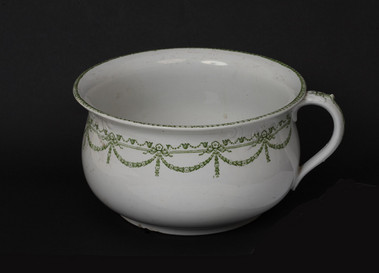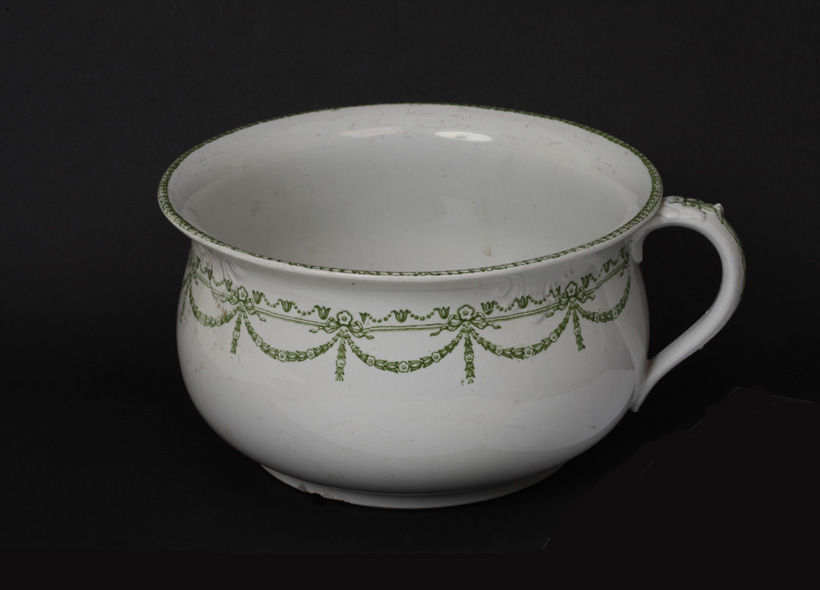Chamber Pot, Victorian, Original
Before houses had indoor toilets a chamber pot was always kept under the bed of both adults and children to save a trip to the outside "privy" at night. If they were used they had to be emptied in the morning into a pail and cleaned out with carbolic soap. In wealthier homes this would have been the job of the chambermaid. This chamber pot has a handle to make it easier to lift. It is made of china and is decorated with a green design as are the basin and jug, which make up a set as a whole.
In 1848 a law was passed that all homes had to have some sort of toilet. Most homes had a simple toilet called a privy. It was usually in a little hut in the garden. The waste from the privy was not flushed away by water but collected in a pit that had to be emptied.
However, the reality for the very poor was somewhat different. In the slums, one cold tap and one toilet were often shared by up to twenty-five families who queued up to use them every morning. This led to hygiene problems and caused epidemics of cholera and typhoid.
With the arrival of plumbing in the 1880s and the invention of the ‘wash-out’ water closet, wealthier people began to get indoor toilets installed into their homes. This new model relied on the rush of water from an overhead cistern to flush away the waste. Nevertheless, the chamber pot was still to be found under the bed for the sake of convenience and many houses built in Victorian times remained without an inside toilet until the 1950s.
In 1848 a law was passed that all homes had to have some sort of toilet. Most homes had a simple toilet called a privy. It was usually in a little hut in the garden. The waste from the privy was not flushed away by water but collected in a pit that had to be emptied.
However, the reality for the very poor was somewhat different. In the slums, one cold tap and one toilet were often shared by up to twenty-five families who queued up to use them every morning. This led to hygiene problems and caused epidemics of cholera and typhoid.
With the arrival of plumbing in the 1880s and the invention of the ‘wash-out’ water closet, wealthier people began to get indoor toilets installed into their homes. This new model relied on the rush of water from an overhead cistern to flush away the waste. Nevertheless, the chamber pot was still to be found under the bed for the sake of convenience and many houses built in Victorian times remained without an inside toilet until the 1950s.

Height:12.8cm

Height:12.8cm

Before houses had indoor toilets a chamber pot was always kept under the bed of both adults and children to save a trip to the outside "privy" at night. If they were used they had to be emptied in the morning into a pail and cleaned out with carbolic soap. In wealthier homes this would have been the job of the chambermaid. This chamber pot has a handle to make it easier to lift. It is made of china and is decorated with a green design as are the basin and jug, which make up a set as a whole.
In 1848 a law was passed that all homes had to have some sort of toilet. Most homes had a simple toilet called a privy. It was usually in a little hut in the garden. The waste from the privy was not flushed away by water but collected in a pit that had to be emptied.
However, the reality for the very poor was somewhat different. In the slums, one cold tap and one toilet were often shared by up to twenty-five families who queued up to use them every morning. This led to hygiene problems and caused epidemics of cholera and typhoid.
With the arrival of plumbing in the 1880s and the invention of the ‘wash-out’ water closet, wealthier people began to get indoor toilets installed into their homes. This new model relied on the rush of water from an overhead cistern to flush away the waste. Nevertheless, the chamber pot was still to be found under the bed for the sake of convenience and many houses built in Victorian times remained without an inside toilet until the 1950s.
In 1848 a law was passed that all homes had to have some sort of toilet. Most homes had a simple toilet called a privy. It was usually in a little hut in the garden. The waste from the privy was not flushed away by water but collected in a pit that had to be emptied.
However, the reality for the very poor was somewhat different. In the slums, one cold tap and one toilet were often shared by up to twenty-five families who queued up to use them every morning. This led to hygiene problems and caused epidemics of cholera and typhoid.
With the arrival of plumbing in the 1880s and the invention of the ‘wash-out’ water closet, wealthier people began to get indoor toilets installed into their homes. This new model relied on the rush of water from an overhead cistern to flush away the waste. Nevertheless, the chamber pot was still to be found under the bed for the sake of convenience and many houses built in Victorian times remained without an inside toilet until the 1950s.
- Term:
- Description:
- Epidemic
- The rapid spread of a disease among people or animals in a particular place.




















